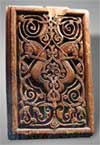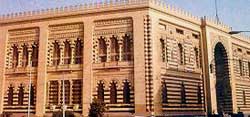|
The Museum Of Islamic Arts
 The Museum of Islamic Arts, dating from 1903, owns an extensive
collection of craft-work, artifacts, manuscripts, and textiles
covering the entire Islamic period in Egypt. Today the museum
contains about 80,000 items and is one of the finest Islamic
collections in the world. The collection was started in 1880 by
Tawfiq, who was Muhammad Ali's grandson. He also had some help
from two historians, Herz and Creswell. Soon the collection had
over 7,000 items and continued to grow through donations,
excavations and purchases. Originally the pieces were kept in
al-Hakim's mosque until 1902. The museum is located at Bab El-Khalq
Square. In the museum, they have gathered the masterpieces into
two easily accessible areas, Halls 2 and 13. In Hall 2, you can
find Umayyad objects which date from the 7th and 8th century. In
Hall 13 there are representations of various types of pottery
and the casket of al-Nasir Muhammad. In the other rooms there
are objects of woodworking, metalworking, armory, ceramics,
glass, books and textiles. The Museum of Islamic Arts, dating from 1903, owns an extensive
collection of craft-work, artifacts, manuscripts, and textiles
covering the entire Islamic period in Egypt. Today the museum
contains about 80,000 items and is one of the finest Islamic
collections in the world. The collection was started in 1880 by
Tawfiq, who was Muhammad Ali's grandson. He also had some help
from two historians, Herz and Creswell. Soon the collection had
over 7,000 items and continued to grow through donations,
excavations and purchases. Originally the pieces were kept in
al-Hakim's mosque until 1902. The museum is located at Bab El-Khalq
Square. In the museum, they have gathered the masterpieces into
two easily accessible areas, Halls 2 and 13. In Hall 2, you can
find Umayyad objects which date from the 7th and 8th century. In
Hall 13 there are representations of various types of pottery
and the casket of al-Nasir Muhammad. In the other rooms there
are objects of woodworking, metalworking, armory, ceramics,
glass, books and textiles.
 Here, Mohammad Ali waited while his forces trapped, and put an
end to the Mamluk beys by massacring most of their leaders as
they were leaving the Citadel. The Kasr (Qasr) El-Gawhara or
Jewel Palace, originally Mohammad Ali Pasha's headquarters, is
now open to the public as an example of the best early 19th
Century Ottoman decoration and architecture. It collection
includes 19th century royal portraits, costumes and furnishings.
Constructed in 1814, it includes a small garden leading to a
mosque with one of the more interesting eccentricities being the
Watch Hall where the shape of a watch has been used to decorate
the walls. Here, Mohammad Ali waited while his forces trapped, and put an
end to the Mamluk beys by massacring most of their leaders as
they were leaving the Citadel. The Kasr (Qasr) El-Gawhara or
Jewel Palace, originally Mohammad Ali Pasha's headquarters, is
now open to the public as an example of the best early 19th
Century Ottoman decoration and architecture. It collection
includes 19th century royal portraits, costumes and furnishings.
Constructed in 1814, it includes a small garden leading to a
mosque with one of the more interesting eccentricities being the
Watch Hall where the shape of a watch has been used to decorate
the walls.
Popular Islamic Places : |